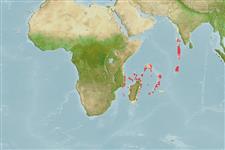>
Gobiiformes (Gobies) >
Gobiidae (Gobies) > Gobiinae
Etymology: Eviota: No etymology given, suggested by Christopher Scharpt: from Latin 'eu' for 'true' and 'iota' for anything very small, in combination 'truly very small' referring to it as being the smallest vertebrate at the time it has benn described by Jenkins (thus, making the suggestion by Scharpt plausible.; springeri: Named for Victor G. Springer..
Environment: milieu / climate zone / depth range / distribution range
Ecología
marino asociado a arrecife; rango de profundidad 0 - 15 m (Ref. 92021). Tropical
Western Indian Ocean: Seychelles (the Amirantes), Cargados Carajos Shoals (Mauritius), Chagos Archipelago, and possibly Sri Lanka.
Tamaño / Peso / Age
Maturity: Lm ? range ? - ? cm
Max length : 1.7 cm SL macho / no sexado; (Ref. 92021)
Short description
Morfología | Morfometría
Espinas dorsales (total): 7; Radios blandos dorsales (total): 8; Espinas anales 1; Radios blandos anales: 7; Vértebra: 25. This species is distinguished from its congeners by the following characters: a dark spot at anterior base of first dorsal fin and one medially at end of caudal peduncle; dorsal/anal fin-ray formula 8/7; cephalic sensory pore system pattern 2, no IT pore; unbranched pectoral-fin rays;
first dorsal fin of male may be elongate; the fifth pelvic-fin ray small, one-tenth to three-tenths length of fourth pelvic fin ray (Ref. 92021).
Life cycle and mating behavior
Madurez | Reproducción | Puesta | Huevos | Fecundidad | Larva
Greenfield, D.W. and S.L. Jewett, 2012. Two new gobiid fishes of the genus Eviota from the Indian Ocean (Teleostei: Gobiidae). Zootaxa 3515:67-74. (Ref. 92021)
IUCN Red List Status (Ref. 130435)
Threat to humans
Harmless
Human uses
Más información
Nombres comunesSinónimosMetabolismoDespredadoresEcotoxicologíaReproducciónMadurezPuestaAgregación para la puestaFecundidadHuevosEgg development
Age/SizeCrecimientoLength-weightLength-lengthLength-frequenciesMorfometríaMorfologíaLarvaDinámica larvariaReclutamientoAbundanciaBRUVS
ReferenciasAcuiculturaPerfil de acuiculturaRazasGenéticaElectrophoresesheritabilidadEnfermedadesProcesamientoNutrientsMass conversion
ColaboradoresImágenesStamps, Coins Misc.SonidosCiguateraVelocidadTipo de nataciónSuperficie branquialOtolitosCerebrosVisión
Herramientas
Special reports
Download XML
Fuentes de Internet
Estimates based on models
Preferred temperature (Ref.
123201): 25.5 - 28.9, mean 27.5 °C (based on 137 cells).
Phylogenetic diversity index (Ref.
82804): PD
50 = 0.5000 [Uniqueness, from 0.5 = low to 2.0 = high].
Bayesian length-weight: a=0.01023 (0.00477 - 0.02194), b=3.02 (2.84 - 3.20), in cm total length, based on LWR estimates for this (Sub)family-body shape (Ref.
93245).
Nivel trófico (Ref.
69278): 3.0 ±0.3 se; based on size and trophs of closest relatives
Fishing Vulnerability (Ref.
59153): Low vulnerability (10 of 100).
